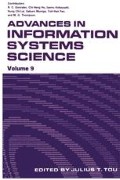Abstract
In a previous publication(1) we discussed the nature of inductive inference and its role in pattern information processing. More specifically, for patterns described in a manner such as that advocated by Michalski(2)—as conjunctions of triplets of the form (name, attribute, value)—we described how inductive inference might be employed systematically to yield decision rules for the classification of such patterns.
Access this chapter
Tax calculation will be finalised at checkout
Purchases are for personal use only
Preview
Unable to display preview. Download preview PDF.
References
Y.-H. Pao and C. H. Hu, Methods for manipulating pattern information: suitable for use in machine intelligence, CWRU Technical Report MI 101–82 (1982).
R. S. Michalski, Pattern recognition as rule-guided inductive inference, IEEE Trans. PAMI 2(4), 349–361 (1980).
W. A. Woods, Transition network grammars for natural language analysis, Commun. ACM 13(10), 591–606 (1970).
S. M. Chou and K. S. Fu, Inference for transition network grammars, Proc. 3rd IJCPR, pp. 79–84 (1976).
Y.-H. Pao and C. H. Hu, A systematic procedure for inductive inference of decision rules applicable to certain instances of pattern recognition, Proc. of 6th IJCPR(1982).
Y.-H. Pao, W. L. Schultz, M. Kiley, J. L. Altman, and A. J. L. Schneider, Implementation of human “judgement” and “experience” in computer-aided interpretation of medical images, Proc. 3rd IJCPR(1976).
J. E. Hopecroft and J. D. Ullman, Formal Languages and Their Relation to Automata, Addison-Wesley, Reading, MA (1969).
M. A. Aiserman, L. A. Gusen, L. I. Rozonoer, I. M. Smirnova, and A. A. Tal’, Logic, Automata, and Algorithms(Translated by Scripta Technica, Inc.; translation editor: G. M. Krane), Academic, New York (1971).
J. R. Sampson, Adaptive Information Processing; An Introductory Survey, Springer-Verlag, New York, (1976).
Author information
Authors and Affiliations
Editor information
Editors and Affiliations
Rights and permissions
Copyright information
© 1985 Plenum Press, New York
About this chapter
Cite this chapter
Hu, CH., Pao, YH. (1985). Processing of Pattern-Based Information: Part II. In: Tou, J.T. (eds) Advances in Information Systems Science. Springer, Boston, MA. https://doi.org/10.1007/978-1-4613-2369-3_4
Download citation
DOI: https://doi.org/10.1007/978-1-4613-2369-3_4
Publisher Name: Springer, Boston, MA
Print ISBN: 978-1-4612-9449-8
Online ISBN: 978-1-4613-2369-3
eBook Packages: Springer Book Archive

